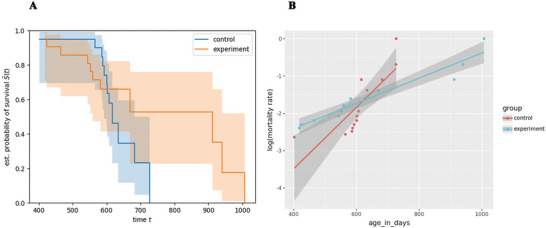Very small treatment groups (N=11), but interesting data nonetheless. I’ve been interested in both of these molecules for awhile and I really hope the ITP includes them in a future cohort. Selegiline is another MAO inhibitor that is included in the 2024 cohort, but it’s more selective for MAO-B, at least at low doses.
Objectives
Targeting partial cellular reprogramming pathways through specific small molecule combinations holds promise for lifespan extension in model organisms. Chemical cocktails like RepSox and tranylcypromine (TCP) may induce beneficial age‐related changes without the risks of full reprogramming. This study investigated the effects of RepSox and TCP on neurological markers, physical activity, skeletal health, and survival in aging C3H female mice.
Methods
Female C3H mice were divided into two age groups: “old” (16–20 months) and “senior” (10–13 months). They received intraperitoneal injections of RepSox (5 mg/kg) and TCP (3 mg/kg) or DMSO (control) every 72 h for 30 days. Physiological state, neurological scores, open field test performance, skeletal deformation, and survival were assessed. Histological analyses of organs (brain, liver, heart, kidneys, lungs, muscles) were performed post‐treatment. Statistical analyses included Mann‐Whitney tests, mixed‐effects linear regression, Kaplan‐Meier survival analysis, and the Gao‐Allison test.
Findings
In the “old” group, treated mice showed enhanced neurological status, fur and skeletal health, and increased cortical angiogenesis, though with some adverse histological changes in the liver and brain. In the “senior” group, treated mice displayed a plateau in mortality after month seven, while deaths continued in controls. Although overall survival was not significantly different, maximum lifespan significantly increased in treated mice (p = 0.039, Gao‐Allison test). Histological findings revealed localized adaptive changes rather than major toxic effects. These results suggest that the combination of RepSox and TCP exerts protective effects on aging phenotypes and may potentially slow systemic aging processes in C3H mice.
3.4. Survival Analysis
Survival assessment of animals in the “senior” group following treatment with the combination of RepSox and TCP initially showed a general decrease in survival rates in both groups. However, from the seventh month onwards, the experimental group did not experience further losses, while the control group continued to decline (Figure 6). Although no statistically significant differences in survival were observed by the log‐rank test (p = 0.246), the difference in ‘maximum’ lifespan was statistically significant according to the Gao‐Allison test (p = 0.039) (Gao et al. 2008).
FIGURE 6.

We also conducted an analysis of mortality rates (Figure 6) and found that the slopes of log‐transformed mortality rates were significantly different: 0.0082 (95% CI: 0.004‐0.012) in the control group vs. 0.0034 (95% CI: 0.003‐0.004) in the experimental group. This might indicate that mice in the experimental group experienced a slower rate of aging according to a Gompertz‐Makeham model.